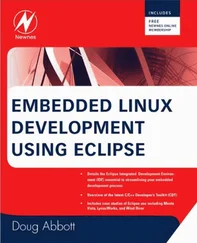CONFIG_PREEMPT_SOFTIRQ reduces latency by running softirqs within the context of the kernel's softirq daemon (ksoftirqd). ksoftirqd is a proper Linux task (process). As such, it can be prioritized and scheduled along with other tasks. If your kernel is configured for real time, and CONFIG_PREEMPT_SOFTIRQ is enabled, the ksoftirqd kernel task is elevated to real-time priority to handle the softirq processing. [119] See Linux Kernel Development, referenced at the end of this chapter, to learn more about softirqs.
Listing 17-3 shows the code responsible for this from a recent Linux kernel, found in .../kernel/softirq.c.
Listing 17-3. Promoting ksoftirq to Real-Time Status
static int ksoftirqd(void * __bind_cpu) {
struct sched_param param = { .sched_priority = 24 };
printk("ksoftirqd started up.\n");
#ifdef CONFIG_PREEMPT_SOFTIRQS
printk("softirq RT prio: %d.\n", param.sched_priority);
sys_sched_setscheduler(current->pid, SCHED_FIFO, ¶m);
#else
set_user_nice(current, -10);
#endif
...
Here we see that if CONFIG_PREEMPT_SOFTIRQS is enabled in the kernel configuration, the ksoftirqd kernel task is promoted to a real-time task (SCHED_FIFO) at a real-time priority of 24 using the sys_sched_setscheduler() kernel function.
SoftIRQ threading can be disabled at runtime through the /proc file system, as well as through the kernel command line at boot time. When enabled in the configuration, unless you specify otherwise, SoftIRQ threading is enabled by default. To disable SoftIRQ threading at runtime, issue the following command as root:
# echo '0' >/proc/sys/kernel/softirq_preemption
To verify the setting, display it as follows:
# cat /proc/sys/kernel/softirq_preemption
1
To disable SoftIRQ threading at boot time, add the following parameter to the kernel command line:
softirq-preempt=0
RCU (Read-Copy-Update) [120] See www.rdrop.com/users/paulmck/RCU/ for an in-depth discussion of RCU.
is a special form of synchronization primitive in the Linux kernel designed for data that is read frequently but updated infrequently. You can think of RCU as an optimized reader lock. The real-time patch adds CONFIG_PREEMPT_RCU, which improves latency by making certain RCU sections preemptable.
The O(1) scheduler has been around since the days of Linux 2.5. It is mentioned here because it is a critical component of a real-time solution. The O(1) scheduler is a significant improvement over the previous Linux scheduler. It scales better for systems with many processes and helps produce lower overall latency.
In case you are wondering, O(1) is a mathematical designation for a system of the first order. In this context, it means that the time it takes to make a scheduling decision is not dependent on the number of processes on a given runqueue. The old Linux scheduler did not have this characteristic, and its performance degraded with the number of processes. [121] We refer you again to Robert Love's book for an excellent discussion of the O(1) scheduler, and a delightful diatribe on algorithmic complexity, from which the notation O(1) derives.
17.3.3. Creating a Real-Time Process
You can designate a process as real time by setting a process attribute that the scheduler uses as part of its scheduling algorithm. Listing 17-4 shows the general method.
Listing 17-4. Creating a Real-Time Process
#include
#define MY_RT_PRIORITY MAX_USER_RT_PRIO /* Highest possible */
int main(int argc, char **argv) {
...
int rc, old_scheduler_policy;
struct sched_param my_params;
...
/* Passing zero specifies caller's (our) policy */
old_scheduler_policy = sched_getscheduler(0);
my_params.sched_priority = MY_RT_PRIORITY;
/* Passing zero specifies callers (our) pid */
rc = sched_setscheduler(0, SCHED_RR, &my_params);
if (rc == -1) handle_error();
...
}
This code snippet does two things in the call to sched_setscheduler(). It changes the scheduling policy to SCHED_RR and raises its priority to the maximum possible on the system. Linux supports three scheduling policies:
• SCHED_OTHER : Normal Linux process, fairness scheduling
• SCHED_RR : Real-time process with a time slicethat is, if it does not block, it is allowed to run for a given period of time determined by the scheduler
• SCHED_FIFO : Real-time process that runs until it either blocks or explicitly yields the processor, or until another higher-priority SCHED_FIFO process becomes runnable
The man page for sched_setscheduler provides more detail on the three different scheduling policies.
17.3.4. Critical Section Management
When writing kernel code, such as a custom device driver, you will encounter data structures that you must protect from concurrent access. The easiest way to protect critical data is to disable preemption around the critical section. Keep the critical path as short as possible to maintain a low maximum latency for your system. Listing 17-5 shows an example.
Listing 17-5. Protecting Critical Section in Kernel Code
...
/*
* Declare and initialize a global lock for your
* critical data
*/
DEFINE_SPINLOCK(my_lock);
...
int operate_on_critical_data() {
...
spin_lock(&my_lock);
...
/* Update critical/shared data */
...
spin_unlock(&my_lock);
...
}
When a task successfully acquires a spinlock, preemption is disabled and the task that acquired the spinlock is allowed into the critical section. No task switches can occur until a spin_unlock operation takes place. The spin_lock() function is actually a macro that has several forms, depending on the kernel configuration. They are defined at the top level (architecture-independent definitions) in .../include/linux/spinlock.h. When the kernel is patched with the real-time patch, these spinlocks are promoted to mutexes to allow preemption of higher-priority processes when a spinlock is held.
Because the real-time patch is largely transparent to the device driver and kernel developer, the familiar constructs can be used to protect critical sections, as described in Listing 17-5. This is a major advantage of the real-time patch for real-time applications; it preserves the well-known semantics for locking and interrupt service routines.
Using the macro DEFINE_SPINLOCK as in Listing 17-5 preserves future compatibility. These macros are defined in .../include/linux/spinlock_types.h.
17.4. Debugging the Real-Time Kernel
Several configuration options facilitate debugging and performance analysis of the real-time patched kernel. They are detailed in the following subsections.
17.4.1. Soft Lockup Detection
To enable soft lockup detection, enable CONFIG_DETECT_SOFTLOCKUP in the kernel configuration. This feature enables the detection of long periods of running in kernel mode without a context switch. This feature exists in non-real-time kernels but is useful for detecting very high latency paths or soft deadlock conditions. To use it, simply enable the feature and watch for any reports on the console or system log. Reports will be emitted similar to this:
Читать дальше












